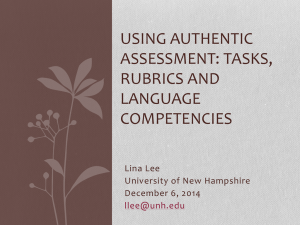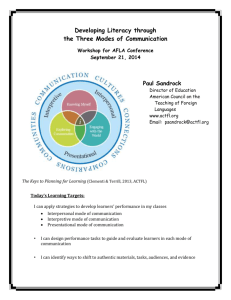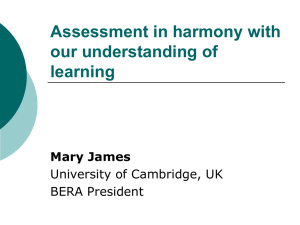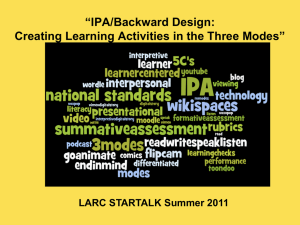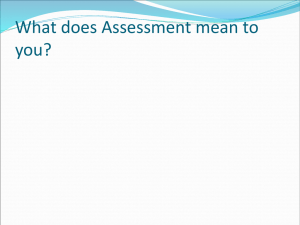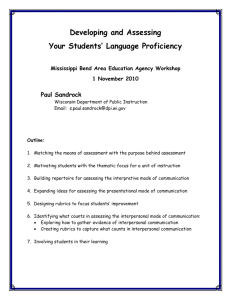PowerPoint - University of Wisconsin
advertisement
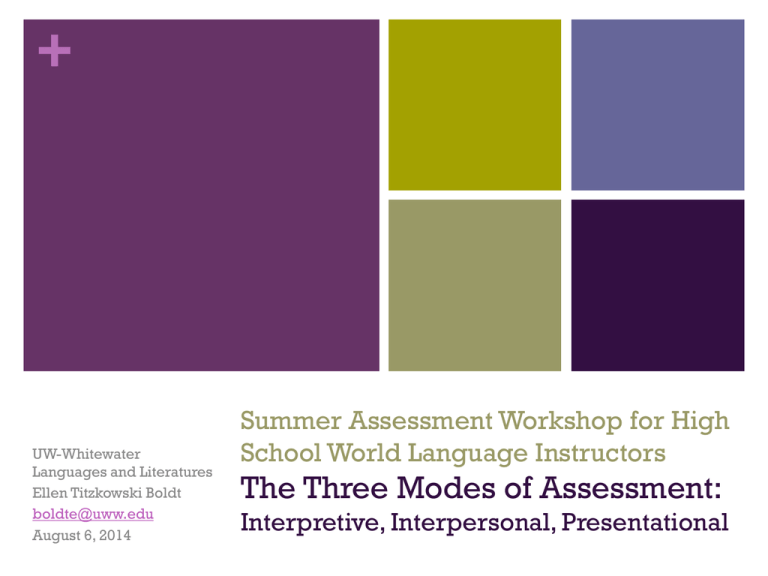
+ UW-Whitewater Languages and Literatures Ellen Titzkowski Boldt boldte@uww.edu August 6, 2014 Summer Assessment Workshop for High School World Language Instructors The Three Modes of Assessment: Interpretive, Interpersonal, Presentational + Overview UNDERSTANDING ASSESSMENT DESIGNING ASSESSMENTS IMPLEMENTING ASSESSMENTS EVALUATING ASSESSMENTS + Overview Introduction The Purpose of Assessment Attitudes Towards Assessment Intended Use of Assessments Developing Effective Assessments Types of Assessments Integrated Performance Assessments (IPA) The Three Modes of Communication Assessing the Modes: Tasks & Strategies Designing Rubrics Performance Assessments Why is assessment important? + Why do we keep doing it in our classrooms, despite the challenges it can present? + The Purpose of Assessment To motivate students To serve as more than a vehicle to assign a grade To drive the instruction (Sandrock 2010) To show evidence that learning is occurring To evaluate the effectiveness of instruction To identify areas needed for improvement + The Purpose of Assessment Assessment is used as a diagnostic tool to describe what students have learned in the past shape future learning goals document progress towards student learning objectives identify areas needing improvement (in instruction and student performance) measure language proficiency, communicative competency, and cultural awareness evaluate teacher effectiveness* WI Educator Effectiveness System DPI *Starting in 2014-2015, all WI educators will be evaluated on student achievement & student learning objectives/outcomes (SLOs). See http://ee.dpi.wi.gov/ for the latest information. + The Purpose of Assessment “Language assessment is the process of using language tests to accomplish particular jobs in language classrooms and programs” (42). “To keep our language assessment practice purposeful, we therefore need to evaluate the extent to which the language testing tools we select and use are actually helping to accomplish the jobs of language assessment in our classrooms and programs” (44). (Norris 2000/2012) + Attitudes towards Assessment http://gratisography.com/ + Attitudes towards Assessment http://gratisography.com/ + Assessment Stakeholders: How do different groups view assessment and why? Stakeholders Teachers Students Administrators Students’ Families Curriculum planners Future employers University admissions counselors (Norris 2000) Step 1: Brainstorm individually Goals? Attitudes? Problems? Step 2: Share and compare Discuss ideas with a partner. Focus on differing motivations. + What makes a good assessment? Discuss in pairs. + Quality and Selection: What makes a good assessment? The selection and perceived quality of an assessment depends on its intended use. + Intended Use of Assessments WHAT? Test Information WHO? Test Users INTENDED TEST USE IMPACT? Test Consequences (Norris 2000) WHY? Test Purposes + Developing Effective Assessments Key questions to ask when creating/selecting the right assessment: Who uses the assessment? What is being assessed? Who/What is impacted? Why? What is the purpose? Specify the intended use of the assessment. Provide a general description of the intended assessment. Note problems and possible solutions. (Norris 2000) + Developing Effective Assessments Purposeful language assessment requires: Acknowledging the context for assessment Focusing on assessment, not just on tests Specifying the intended use(s) of the assessments(s) Evaluating the outcomes of the assessment(s) (Byrnes 2001; Norris 2000) + Developing Effective Assessments What does purposeful assessment look like? Identifying the thematic and cultural contexts Setting attainable benchmarks or learning targets Creating classroom activities to support student success on performance assessments Synthesizing language and content instruction Fostering task-based instruction Developing both formative and summative assessments Involving all three modes of assessment Embedding assessments into curriculum + Assessment Models Common Level- Assessments and course-specific assessments Formative Exit vs. Summative vs. Prototypical interviews (OPI, SOPI, MOPI) Content-based, task-based, genre-specific Performance Three Assessments Modes of Communication 5 C’s of the National Standards + Types of Assessments Traditional Assessment Tools Focus on: grammatical accuracy focus on form vocabulary building discrete learning checks Alternative Performance Assessment Tools Focus on: communication application of learning authentic language use performance of real world tasks meaningful contexts proficiency development integration with standards 3 modes of communication teaching to the “test” (Sandrock 2010) + Types of Assessments Assessment is a continuum. Teachers need to provide students with a variety of feedback on various types of assessment across the spectrum, including: specific and focused feedback holistic and broad feedback Formal (rubrics) and informal (learning checks) feedback A balanced assessment system = both formative and summative assessments. (Sandrock 2010) + Types of Assessments Formative Assessment Summative Assessment Learning checks, guided activities with teacher support End-of-unit, end-of-course assessment (no support) Informs and modifies instruction, classroom activities and student learning Demonstrates knowledge gained without teacher assistance Builds students’ confidence Motivates students Scaffolds information to be used in summative performance assessments Showcases application of various skills learned via formative assessments May focus more on specific learning targets (i.e. grammar concepts, vocabulary) Synthesizes a variety of communication skills and language concepts + Characteristics: The 3 Modes of Communication Interpretive Mode: listening, reading, viewing authentic, text-based (audio, written, video/film) materials monologic tasks (one-way communication) Interpersonal Mode: spontaneous communication (oral or written) negotiation of meaning dialogic tasks (two-way communication) Presentational Mode: speaking, writing monologic tasks (one-way communication) Rehearsed language usage + The 3 Modes of Communication Interpersonal Interpretive Presentational Active negotiation of meaning among individuals Interpretation of what the author, speaker, or producer wants the receiver of the message to understand Creation of messages Participants observe and monitor one another to see how their meanings and intentions are being communicated One-way communication with no recourse to the active negotiation of meaning with the writer, speaker, or producer One-way communication intended to facilitate interpretation by members of the other culture where no direct opportunity for the active negotiation of meaning between members of the two cultures exists Adjustments and clarifications are made accordingly Interpretation differs from comprehension and translation in that interpretation implies the ability to read (or listen or view) “between the lines,” including understanding from within the cultural mindset or perspective To ensure the intended audience is successful in its interpretation, the “presenter” needs knowledge of the audience’s language and culture Speaking and listening (conversation); reading and writing (text messages or via social media) Reading (websites, stories, articles), listening (speeches, messages, songs), or viewing (video clips) of authentic materials Writing (messages, articles, reports), speaking (telling a story, giving a speech, describing a poster), or visually representing (video or PowerPoint) (ACTFL Performance Descriptors for Language Learners 2012) + Standards-Based Performance Assessment Interactive graphic: http://wimedialab.org/worldlanguageassessment/clover.htm + Assessment: Interpretive Mode How do you typically assess students’ abilities to communicate in the interpretive mode? + Assessment: Interpretive Mode Interpretive Assessment Task = Demonstrate literal comprehension (keys words, main ideas, details) and interpretive comprehension (word and concept inferences, cultural perspectives, author intent, text organization). Use a comprehension guide (worksheets, Q&A, creating or identifying images based on descriptions, etc.) to document both levels of comprehension. Strategies for Developing Interpretive Communication Routinely incorporate authentic listening, viewing, and reading texts/tasks into classroom instruction skimming, scanning, identifying language patterns. Encourage focused listening/viewing/reading of smaller textual chunks and teach comprehension strategies context clues, word families, textual organization (headings, captions, photos). Design group activities that allow for collaborative interpretive skills. Assist students as they move from literal comprehension to interpretive comprehension goals. (Sandrock 2010: 83) + Considerations for text selection (Intermediate Level) Assessment: Interpretive Mode Assessment targets ability to detect main ideas and supporting details. Texts should focus on simple narratives, routines, familiar contexts, personal experience. Include a range of sentence lengths from simple to paragraph-length text. Topics should be of high interest to students and include cultural content from the target culture(s) to allow comparison and contrast to their own cultural practices. (Sandrock 2010: 82) + Assessment: Interpretive Mode Sources for authentic READING texts(highly contextualized & thematically appropriate) product advertisements public service campaign announcements interviews/surveys from youth magazines Sources for authentic LISTENING & VIEWING texts (highly contextualized & thematically appropriate) commercials (TV/radio) public service campaign announcements simple TV or soap opera segments poems simple stories Interviews genre-specific letters/email talk show excerpts advice columns film excerpts personal ads songs photo stories with captions comic strips/cartoons simple news articles podcasts resumes descriptions (art/photos in museum guides; directions) (Sandrock 2010: 82) + Assessment: Interpersonal Mode How do you typically assess students’ abilities to communicate in the interpersonal mode? + Assessment: Interpersonal Mode Interpersonal Assessment Task = Two (or more) students exchange information spontaneously, as well as express opinions, feelings, and emotions with each other The student(s) may have information the other(s)do not have, thus creating an information gap and purposeful exchange of real information and negotiation of meaning. Generally no notes or written support are allowed. Strategies for Developing Interpersonal Communication Incorporate regular classroom activities that require interpersonal communication to lower students’ anxiety levels for later assessments practice spontaneous speech in non-evaluation situations use discourse markers and key phrases to negotiate meaning reduce reliance on written notes and support negotiate meaning via information gap tasks allow students to interact with a range of peers and their different proficiencies (mutual benefit of modeling and support) (Sandrock 2010: 83) + Assessment: Interpersonal Mode Example Interpersonal Tasks (with partners or in small groups) Information gap tasks Interviews Cultural comparisons Discussions opinions reactions pros/cons personal perspectives + Assessment: Presentational Mode How do you typically assess students’ abilities to communicate in the presentational mode? + Assessment: Presentational Mode Presentational Assessment Task = Students create a message to communicate to an audience by means of a written or spoken language product. Monologic task one-way communication Often used as a summative task after building upon previous interpretive and interpersonal tasks. Presentational rubrics often evaluate “impact, which refers to the degree to which the message maintains the attention of the reader or listener. The teacher should explore with students strategies for creating presentational products that have impact (e.g. selection of topic, use of visuals, choice of words, visual layout)” (Sandrock 2010: 84). + Assessment: Presentational Mode Strategies for Developing Presentational Communication Use a process-oriented approach (drafts, peer-editing, revisions, rewrites, scripts, rehearsals, videotape) to allow for a variety of feedback opportunities. Incorporate peer- and self-evaluation into the feedback loop. Address the issue of “impact” in your rubric. Discuss and practice evaluating the “impact” of various presentational messages in a variety of authentic and studentproduced products. Create a balanced rubric task appropriateness content language usage (Sandrock 2010: 84) + Assessment: Presentational Mode Example WRITING tasks Essay Poem Letter (genre-specific) Email (context-specific) Advertisement/Flyer Blog post Description Glogster Journal Entry Photo essay with captions Example SPEAKING Tasks Speech Monologue Voice mail Video Commercials Podcast Short play News broadcast Digital Story Genre-specific speech (eulogy, campaign, etc.) + Designing Alternative Assessments Task and assessment instruments must fit the intended purpose for the student learning objective and connect to the standards. Effective assessments (formative, summative, informal and formal) should be situated in a meaningful thematic context with real world application and authentic language use. Transparency: Assessment ≠ Mystery What is the goal of the specific assessment? Informing students about the expectations and communicative goals fuels student motivation. Discuss well-crafted rubrics at the beginning of the unit so that students understand what the expected performance involves. (Sandrock 2010: 28) + Designing Performance Assessments Backward By Design first selecting the intended goal, performance assessments can function as a filter for selection the content needed to achieve the student learning outcome(s) in a unit. What is necessary to complete the task(s)? Develop an essential question based on the content/thematic unit in order to determine the tasks. Create learning targets and formative assessments to build towards summative performance assessments in the three modes. + Templates for Designing Performance Assessments Download the Blank Curriculum Planning Template http://wimedialab.org/worldlanguageassessment/re sources.htm Templates for designing integrated performance assessment tasks in future thematic units Copies are in your folder for use in afternoon workshop session (Sandrock 2010: 34) and with workshop handouts/references online. Nature Unit detailed example With workshop handouts/references online + Example Unit: Clothing (Intermediate Level) Essential Question: What do clothes say about a person? Mode Interpretive Read & answer Performance questions from an Assessment authentic article in a fashion magazine about current trends. Interpersonal Presentational Interview a partner about their personal style preferences in various contexts and what they project. Fashion Show:Write and present a text describing and a peer’s outfit and comment on what trends & image(s) it projects in which contexts. In-Class Practice Read & analyze culturally authentic clothing advertisements online. Info-gap tasks describing outfits/ style; view/analyze YouTube interviews “Kleider machen Leute” outfit/personality perceptions Describe outfits in writing (draft & revise); describe orally what others are wearing, how the clothes they fit and what they project about the wearer. Necessary Language, Structures, Functions, Cultural Info Clothing vocab Adjectivesstyles/trends Pricing in Euros European sizing Question-Answer Dative verbs Personal Pronouns Comparative/Superlativ e Express opinions Adjective endings (synthesis and application of everything previously listed) + Sequencing Performance Assessments ACTFL suggests a sequenced approach: 1. Interpretive assessment 2. Interpersonal assessment 3. Presentational assessment This methods allows each assessment to build on the following one, securing vocabulary and language functions from textual modeling via authentic texts in the interpretive mode which are needed to be successful in the interpersonal and presentational modes when the language becomes productive. There is some debate about the last two steps since spontaneous dialogic communication with its inherent negotiation of meaning may appear more complex than monologic presentational tasks, such as writing and speaking (Tedick, D & Cammarata, L. 2014). + Rubrics Rubrics are a necessary tool for teachers and students to evaluate communication. Rubrics must describe the expected performance and provide useful, targeted feedback. Does not meet expectations Meets expectations Exceeds expectations Rubrics should demonstrate how increased proficiency can be achieved so students know what to aim for. + Rubrics Share rubrics with students to allow familiarity and goals for expected performance levels. Model rubric evaluation with students via sample performances. Examples (included in your folders) ACTFL Performance Descriptors for Language Learners (2012) can serve as a basis for creating rubrics. UW-Whitewater Rubrics based partially on the ACTFL Performance Descriptors for Language Learners (1998 Version) & ACTFL Proficiency Guidelines Presentational-Writing Rubric Presentational-Speaking Rubric Interpretive Rubric (Assessing Textual Literacy) + K-12 Assessment Resources in WI Get in the Mode: Assessment Videos (2008) http://www.youtube.com/watch?v=oAJ8ZqanZr4 &list=PL77DDFFFF389160BB&index=6 http://wimedialab.org/worldlanguageassessmen t/video.htm Challenges + Time Constraints Class size Curriculum Departmental Involvement Student Attitudes “test” or “performance” anxiety http://gratisography.com/ + Final Thoughts “Assessment is perhaps one of [the] most difficult and important parts of our jobs as teachers. Ideally, it should be seen as a means to help us guide students on their road to learning. No single procedure can meet the needs of all learners and situations, so we need to remember to incorporate a variety of tools to help our students know how they are progressing and to gauge the effectiveness of our own methodology and materials.” ~ Jerrold Frank (Frank 2012: 32) + Final Thoughts Assessment… …is more than a test. …is all the things along the way that prepare students. …builds on itself to help students progress. …needs to be both formative and summative. …can be informal and formal. …provides opportunities for meaningful feedback. …needs to be purposeful and meaningful for students. …is motivational by setting a clear path for performance goals. …drives instruction. …is integrated in the classroom and allows for evaluation of all three modes of communication interpretive, interpersonal, presentational. + Final Thoughts “Language assessment…is much more than simply giving a language test; it is the entire process of test use. Indeed, the ultimate goal of language assessment is to use tests to better inform us on the decisions we make and the actions we take in language education.” ~John M. Norris (Norris 2000/2012: 42) + References American Council on the Teaching of Foreign Languages. (2012). ACTFL performance descriptors for language learners, 2012 Edition. Alexandria, VA: ACTFL. Byrnes, H. (2001). Faculty assessment and evaluation: additional considerations. ADFL Bulletin, 32(3), 34-36. http://www.actfl.org/sites/default/files/pdfs/PerformanceDescriptorsLa nguageLearners.pdf http://www.adfl.org/bulletin/V32N3/323034.htm Frank, J. (2012). The roles of assessment in language teaching. English Teaching Forum, 50(3), 32. http://americanenglish.state.gov/files/ae/resource_files/50_3_7_frank.p df + References Norris, J. M. (2014, April). How do we assess task-based performance? Invited LARC/CALPER testing and assessment webinar. http://larc.sdsu.edu/testassesswebinar/jnorris/Norris_TaskBasedAssessment_PPT.pdf Norris, J.M. (2012). Purposeful language assessment. English Teaching Forum, 50(3), 41–45. (Reprinted from Norris, J.M. (2000). Purposeful language assessment. English Teaching Forum, 38(1), 18–23.) http://americanenglish.state.gov/files/ae/resource_files/50_3_10_norris.pd f Sandrock, P. (2010). The keys to assessing language performance: A teacher’s manual for measuring student progress. Alexandria, VA: ACTFL. Tedick, D & Cammarata, L. (2014). "Integrated Performance Assessment: Adapting the Model for CBI." [online http://carla.acad.umn.edu/cobaltt/modules/assessment/ipa/index.html + Questions? Feedback? Contact me at boldte@uww.edu http://gratisography.com/

